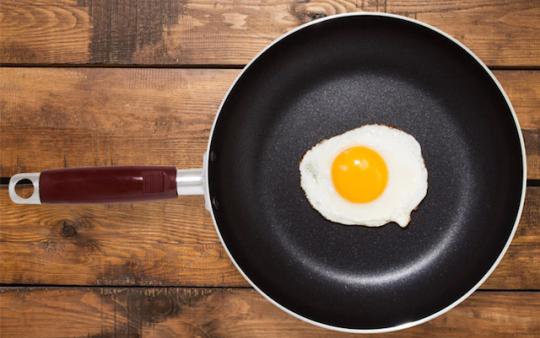Non-stick chemical coatings and fabric treatments promise to make life easier. Scrub less, launder less, and worry less – sounds promising, right? Life with kids can be a messy business and the prospect of putting less effort into cleaning is appealing. But saving a bit of time on on elbow grease could cost you more than a few extra dollars.
Toxins that stick it to the environment
Research shows that some perfluorinated compounds (PFCs), the family of chemicals that make pans “non-stick”, such as the now-banned PFOS (perfluorooctane sulfonate) and PFOA, are linked to cancer and can be toxic to developing brains. That means pregnant women, and the developing fetus, are especially vulnerable. Scientists have found some chemicals in the PFC family to be more toxic than others, and some PFCs are still being assessed to determine whether or not they have the potential to impact human health. But even if a product is safe for your health and for your kids, if it pollutes the environment when being manufactured, and later disposed of, that’s another good reason to make a switch.
PFCs are widely used in food packaging, particularly for fast food and in microwave popcorn bags. These chemicals don’t break down very easily in the environment and have even been found to contaminate the Arctic. Smaller animals such as fish ingest persistent PFCs and other pollutants, and these smaller animals are then eaten by larger predators, allowing the chemicals move up through the food chain. Whether it’s a mama polar bear or humans, whoever is at the top of the food chain ends up ingesting a concentrated dose of the toxic pollutants.
Switch away from non-stick
For some non-stick products, there is little risk with normal daily usage. But problems may arise with improper use, for example, non-stick pans when used on high heat can release PFCs into food. Pans with non-stick chemicals are also more likely to contaminate food once the coatings are scratched and have begun to break down. If you have a non-stick pan that is starting to look worse for the wear, it may be a good time to switch to stainless steel, ceramic or cast iron.
Luckily, some PFCs have been phased out of industrial production, but others like PFOA (perfluorooctanoic acid) remain on the market in products with non-stick coatings, food packaging, and fabrics with water-resistant treatments. PFOA is used to make Gore-Tex and Teflon products, such as non-stick cookware, and the UN has recently recommended banning it.
What can you do to protect your family and the environment from these questionable chemicals? Try these tips:
- The next time you go shopping for pots, pans and cooking utensils, skip the non-stick cookware. Instead, opt for cast iron, stainless steel, or ceramic cookware, and wooden or bamboo cooking utensils.
- If you already have non-stick cookware, avoid using it on high heat or scratching the material.
- When possible, avoid purchasing stain and water-repellant clothing and furniture. Go for natural fabrics and materials instead.
- Vacuum and air out your home frequently as PFCs accumulated in house dust are a major source of exposure.
For more tips and to learn how to avoid other toxic chemicals and reduce pollution, check out Environmental Defence’s handy Toxic Ten Pocket Guide.
*Originally published October 22, 2016




